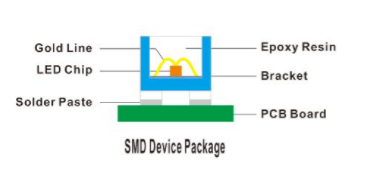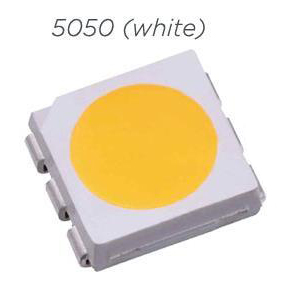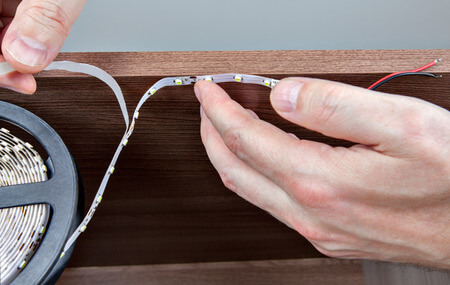LED strip performance degradation is often manifested as a color change, light yellowing is a good indicator of the quality and durability of LED strip lights.

The basic structure of the LED light strip is an electroluminescent semiconductor material chip, which is cured on the bracket with silver glue or white glue, then connects the LED chip and the circuit board with silver or gold wire, and then seals with epoxy resin around it which plays the role of protecting the inner core wire, and finally install the shell.
The yellowing of white led strip lights is related to LED quality, but the main reasons are that the temperature of the white led strip is overheated, and use PU glue that will turn yellow after long-term use to encapsulate the strip.
Influencing Factors Of Yellowing Of LED Strip Lights
1. LED Quality
LED light-emitting technology uses diode blue light technology to mix yellow phosphors to emit white light. Therefore, the amount of blue light produced by the components will decrease after aging. At this time, the proportion of yellow light will increase, and the emitted light will turn yellow.
During the installation process or welding process, if the white led strip lighting is affected by tin, it will cause the phosphor to produce vulcanization and lose its effect.


If the SMD LEDs are of good quality and airtight, it is not easy to be invaded by the outside, and can reduce the possibility of yellowing.
Defects in the production process may lead to the heat dissipation of the white LED chip that cannot be well derived from the pin, which causes the excessive temperature of the LED chip to increase the chip attenuation.
If the white led light strips use bad LED chips, it will also cause the white LED light to turn yellow because the brightness of the LED lights will decay faster.
Regarding LED brightness attenuation, there is another problem here. Why is the LED light getting darker? There is light decay in the led strip lights. After a period of use, its light intensity will gradually decrease and cannot be restored. The reduced part is called the light decay of the LED. And light decay is inevitable. This is why the LED light dims after using the light strip for a period of time.
2. Temperature Overheating
When installing white color led strip lights in kitchens, cabinets, and other indoor or outdoor places, we usually install led light strips under the counter or under cabinets to meet our lighting or atmosphere requirements, and most of these places are wooden surfaces.

Choose to install white led strips on the surface of wooden furniture, and due to the poor heat dissipation of wood, the heat generated by long-term use of the white led lighting strips cannot be quickly discharged, which may cause the white light led strips to overheat and age and turn yellow.
However, installing white led strip lights on the ceramic and marble surface will not produce this problem, because ceramics and marble have better heat dissipation conditions than wood.
Most people like to install white led strip lights behind the TV and under the bed to bring themselves different mood experiences. I have to admit that sometimes owning an led strip light is much better than not owning it. However, taking into account the heat dissipation requirements, running the led strip light in a narrow space requires good ventilation conditions to lower the ambient temperature.
Another way to dissipate heat is to install LED aluminum channels. The installation of aluminum channels on the wood surface can compensate for the poor heat dissipation of wood and achieve better heat dissipation.
3. Use A Waterproof Seal That Turns Yellow Easily
IP65 waterproof led strips are covered with a glue layer on the PCB surface to achieve indoor splash-proof performance. Some led strip sellers use cheap PU glue to complete the production of IP65 strips.
But PU glue has a fatal disadvantage is that it is easy to oxidation, after the use of 6-12 months, it will yellow, the yellowing glue layer will automatically be separated from the PCB attachment surface.
However, the PU adhesive layer after aging and solidification has a very high hardness, with good durability, and easy to clean.
Nowadays, high-quality led strip light suppliers use silicon as the waterproof layer of led light strips, it will not turn yellow after 5-10 years of use.
But it is not recommended to install the silicone led strip in the environment where it is easy to be touched and rubbed, it will damage the strip surface to some extent and affect its luminous effect.
How To Prevent LED Strip Lights From Turning Yellow?
- Choose high-quality white led light strips. Good light strip sellers and good products are worth your investment. Very cheap light strips, although price-friendly, may not necessarily bring you a satisfying experience.
- Adhere the strip to an object surface that dissipates heat well, such as ceramic or marble. If installing on wood surfaces, use aluminum profiles to enhance heat dissipation.
- Build good ventilation for your LED strip to cool the ambient temperature and avoid overheating.
- Use silicone material as the waterproof layer of the light strip instead of PU glue.
How Do You Fix Yellowing LED Lights?
If the yellowing is only caused by dust on the surface of the strip, a low concentration of alcohol wipes will solve the problem. If the problem is more serious, the strip may need to be replaced.
Final Words
The white led strip lights will age and turn yellow after long-term use, which is still a problem that needs to be overcome. What we can do is delay its aging and yellowing speed. As long as the white led light strip is used correctly, we can still enjoy it for a long time.